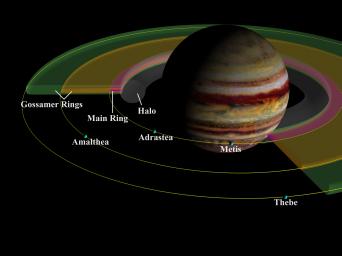This schematic cut-away view of the components of Jupiter's ring system shows the geometry of the rings in relation to Jupiter and to the small inner satellites, which are the source of the dust which forms the rings.
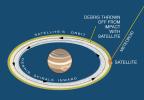
The Formation of Jupiter's Ring System
The innermost and thickest ring, shown in gray shading, is the halo that ends at the main ring. The thin, narrow main ring, shown with red shading, is bounded by the 16- kilometer-wide (10-miles) satellite Adrastea and shows a marked decrease in brightness near the orbit of Jupiter's innermost moon, Metis. It is composed of fine particles knocked off Adrastea and Metis. Although the orbits of Adrastea and Metis are about 1,000 kilometers (about 600 miles) apart, that separation is not depicted in this drawing. Impacts by small meteoroids (fragments of asteroids and comets) into these small, low-gravity satellites feed material into the rings. Thebe and Amalthea, the next two satellites in increasing distance from Jupiter, supply dust which forms the thicker, disk-like "gossamer" rings. The gossamer rings, depicted with yellow and green shading, are thicker because the source satellites orbit Jupiter on inclined paths
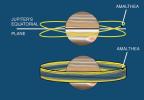
Satellite Interactions with Jupiter's Ring System
These small satellites all orbit closer to Jupiter than the four largest Galilean satellites, Io, Europa, Ganymede and Callisto, which were discovered nearly 400 years ago. The orbital distances of the moons are drawn relative to the size of Jupiter.
| Jupiter's Main Ring and Inner Satellites |
|---|
| Side view of system: | Overhead view of system: |
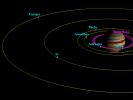 | 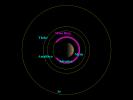 |
The Jupiter image was created from a map based on data obtained by the Hubble Space Telescope.
JPL manages the Galileo mission for NASA's Office of Space Science, Washington, DC. The images are posted on the Internet at https://photojournal.jpl.nasa.gov/ and at http://solarsystem.nasa.gov/galileo/. Background information and educational context for the images can be found at: http://www.jpg.nasa.gov/galileo/sepo.

 Planetary Data System
Planetary Data System











